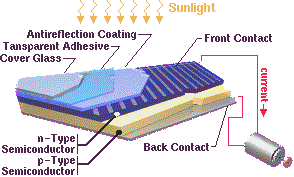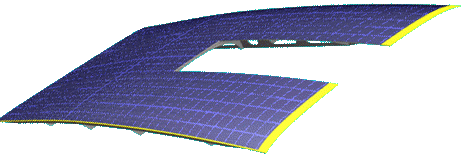|
|||||||||||||||||||||
|
SOLAR ARRAY and POWER TRACKERS
We recommend a solar array created from individual solar cells as opposed to one made of prefabricated solar panels. It enhances the students' learning and can result in a lighter solar array. Cells can be bought from either Siemens or ASE Americas.
Both sell the terrestrial-grade cells that are permitted in most solar challenges, and the cost for terrestrial-grade cells are much lower than space-grade cells, though terrestrial-grade is less efficient. Each solar cell should produce .5 volts at about 3 amps at peak sunlight. The number of cells to use depends on their size and the allowable solar area for the rules of an event. Solar cells should be wired in series on a panel and should be divided into several zones. For example, if you have 750 solar cells, you might want to wire 3 sets of 250 cells, each zone producing about 125 volts. If one zone fails, two other zones are still producing power.
The solar array voltage does not need to match the system voltage of the motor if you use power trackers. Power trackers convert the solar array voltage to the system voltage. They are essential in a solar car. Be sure to verify with the power tracker vendor the necessary array voltage to feed the power trackers. If the car drives underneath shade, the power trackers automatically adjusts the power to match system voltage, allowing the system to run as efficient as possible. Power trackers are available from AERL.
WHAT IS A SOLAR CELL
A solar cell converts solar energy to electrical energy. Photons in sunlight provide the energy that moves electrons from one layer of a semi-conducting metallic wafer to another. The movement of the electrons creates a current.
Solar cells are devices which convert solar energy directly into electricity. The most common solar cells function by the photovoltaic effect. Photo- means light and -voltaic means electrical current or electricity. (light-electricity) A solar cell supplies direct current (DC) electricity that can be used to power DC motors and light bulbs among other things. Solar cells can even be used to charge rechargeable batteries so that electricity can be stored or transported for later use when the sun is not available. There are primarily two types of cells used today, silicon and gallium arsenide, which come in several different grades and varying efficiencies. The satellites that orbit the earth typically use gallium arsenide, while silicon is more commonly used for Earth based (terrestrial) applications.
Photovoltaic cell semiconductor layers
Stock class solar cars use commerically available terrestrial grade silicon cells. Numerous individual cells (approaching 1000) are combined to form the "solar array". Depending on the electric motor used to drive the car, these arrays generally work between 50 and 200 volts, and can provide up to around 1000 watts of power. The intensity of the sun, cloud cover, and temperature affect the array's output.
Open class solar cars can use any type of solar cell and many teams use the space grade cells. These cells are generally smaller and much more expensive than the conventional silicon cells. They also are more efficient. Photovoltaic cells are a relatively technology. Their development and use has come about as part of the technology developed for space travel and satellite communication systems.
The word Photovoltaic is a combination of the Greek word for Light and the name of the physicist Allesandro Volta. It identifies the direct conversion of sunlight into energy by means of solar cells. The conversion process is based on the photoelectric effect discovered by Alexander Bequerel in 1839. The photoelectric effect describes the release of positive and negative charge carriers in a solid state when light strikes its surface.
HOW DOES A SOLAR CELL WORK
Solar cells are composed of various semiconducting materials. Semiconductors are materials, which become electrically conductive when supplied with light or heat, but which operate as insulators at low temperatures.
Over 95% of all the solar cells produced worldwide are composed of the semiconductor material Silicon (Si). As the second most abundant element in earth`s crust, silicon has the advantage, of being available in sufficient quantities, and additionally processing the material does not burden the environment. To produce a solar cell, the semiconductor is contaminated or "doped". "Doping" is the intentional introduction of chemical elements, with which one can obtain a surplus of either positive charge carriers (p-conducting semiconductor layer) or negative charge carriers (n-conducting semiconductor layer) from the semiconductor material. If two differently contaminated semiconductor layers are combined, then a so-called p-n-junction results on the boundary of the layers.
At this junction, an interior electric field is built up which leads to the separation of the charge carriers that are released by light. Through metal contacts, an electric charge can be tapped. If the outer circuit is closed, meaning a consumer is connected, then direct current flows. Silicon cells are approximately 10 cm by 10 cm large (recently also 15 cm by 15 cm). A transparent anti-reflection film protects the cell and decreases reflective loss on the cell surface.
Photovoltaics: Solar Electricity and Solar Cells in Theory and Practice
The word Photovoltaic is a combination of the Greek word for Light and the name of the physicist Allesandro Volta. It identifies the direct conversion of sunlight into energy by means of solar cells. The conversion process is based on the photoelectric effect discovered by Alexander Bequerel in 1839. The photoelectric effect describes the release of positive and negative charge carriers in a solid state when light strikes its surface.
Photovoltaic cell construction
Characteristics of a Solar Cell
The usable voltage from solar cells depends on the semiconductor material. In silicon it amounts to approximately 0.5 V. Terminal voltage is only weakly dependent on light radiation, while the current intensity increases with higher luminosity. A 100 cm² silicon cell, for example, reaches a maximum current intensity of approximately 2 A when radiated by 1000 W/m².
The output (product of electricity and voltage) of a solar cell is temperature dependent. Higher cell temperatures lead to lower output, and hence to lower efficiency. The level of efficiency indicates how much of the radiated quantity of light is converted into useable electrical energy.
Different Cell Types
One can distinguish three cell types according to the type of crystal: monocrystalline, polycrystalline and amorphous. To produce a monocrystalline silicon cell, absolutely pure semiconducting material is necessary. Monocrystalline rods are extracted from melted silicon and then sawed into thin plates. This production process guarantees a relatively high level of efficiency.
|
|
1. Chassis - and seating |
|
2. Mechanics - suspension, steering, brakes |
5. Solar Array - usually part of body |
7. Electrical System - and instruments |
8. Driver Controls - switches, lighting, etc |
9. Bodywork - Screen, etc |
LINKS:
A taste for adventure
Solar Cola - a healthier alternative.
EDUCATION | SOLAR CAR RACING TEAMS | SOLAR CAR RACING EVENTS | FILMS | MUSIC
The
content of this website is copyright © and design copyright 1991 and
2019 Electrick Publications. All rights reserved. The bluebird
logo ![]() and
name Bluebird
and Blue Max are trademarks.
The BE2 and BE3 vehicle shape and configuration are registered designs
®. All other trademarks
are hereby acknowledged. Max Energy Limited is
an environmental educational charity.
and
name Bluebird
and Blue Max are trademarks.
The BE2 and BE3 vehicle shape and configuration are registered designs
®. All other trademarks
are hereby acknowledged. Max Energy Limited is
an environmental educational charity.

